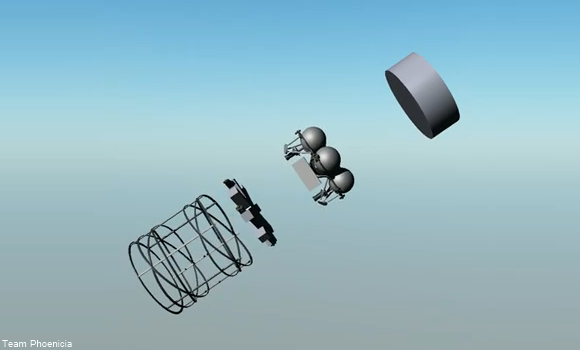 |
| Meandering line of boulders at the bottom of Necho crater. Image width is 690 m, LROC Narrow Angle Camera (NAC) observation M167390131L, LRO orbit 9802, August 7, 2011; incidence angle 47.08° at 0.69 meters resolution, from 60.11 km. Sunlight is from west (left side) [NASA/GSFC/Arizona State University] |
Hiroyuki Sato
LROC News System
Today's Featured Image highlights the southern edge of an impact melt pond, located on the floor of Necho crater. Necho is a relatively young, Copernican-aged crater (meaning, it formed between ~1.1 billion years ago and the present) with a diameter of 30 km, located on the farside of the Moon (5.25°S, 123.24°E).
As seen in the WAC context image below, the crater floor is filled by impact melts. The meandering line of boulders in the opening image was found near the bottom of a north to northeast facing slope. There is no clear relief or texture difference on the surface except this boulder line. How was it formed?
Probably this line of boulders was formed as a splash mark or wave front coming from the melt pond, driven by secondary impacts or debris dumped into the melt pond. In fact, impact melt flows frequently retain similar boulder lines along the edge of each flow unit (see Scale-like Impact Melts, A molten flood). Also, discontinuous boulder marks at the upper part of this image extend downslope, near the relatively level melt pond area, which might be a side of the splash flow.
Explore the full NAC view of Necho's impact melt pond HERE.
Related Posts:
Necho Crater (August 22, 2009)
A molten flood (July 28, 2010)
Necho's terraces (August 31, 2010)
Impact melt at Necho crater (September 1, 2010)
The jumbled floor of Necho crater (September 2, 2010)
Impact melt in Anaxagoras crater (May 31, 2011)
LROC: Jackson Waves, (August 10, 2011)
Scalelike Impact Melts (April 19, 2012)
LROC News System
Today's Featured Image highlights the southern edge of an impact melt pond, located on the floor of Necho crater. Necho is a relatively young, Copernican-aged crater (meaning, it formed between ~1.1 billion years ago and the present) with a diameter of 30 km, located on the farside of the Moon (5.25°S, 123.24°E).
As seen in the WAC context image below, the crater floor is filled by impact melts. The meandering line of boulders in the opening image was found near the bottom of a north to northeast facing slope. There is no clear relief or texture difference on the surface except this boulder line. How was it formed?
 |
| Necho crater as viewed on the digital terrain model available in the Google Earth application, overlaid with the 604nm monochrome data from LROC Wide Angle Camera observation M165041995C, LRO orbit 9456, July 11, 2011; resolution 86.15 meters from 61.3 km. The locations of full NAC frame (blue box) and the field of view highlighted in the LROC Featured Image (yellow arrow) are indicated [NASA/GSFC/Arizona State University]. |
Explore the full NAC view of Necho's impact melt pond HERE.
Related Posts:
Necho Crater (August 22, 2009)
A molten flood (July 28, 2010)
Necho's terraces (August 31, 2010)
Impact melt at Necho crater (September 1, 2010)
The jumbled floor of Necho crater (September 2, 2010)
Impact melt in Anaxagoras crater (May 31, 2011)
LROC: Jackson Waves, (August 10, 2011)
Scalelike Impact Melts (April 19, 2012)











































